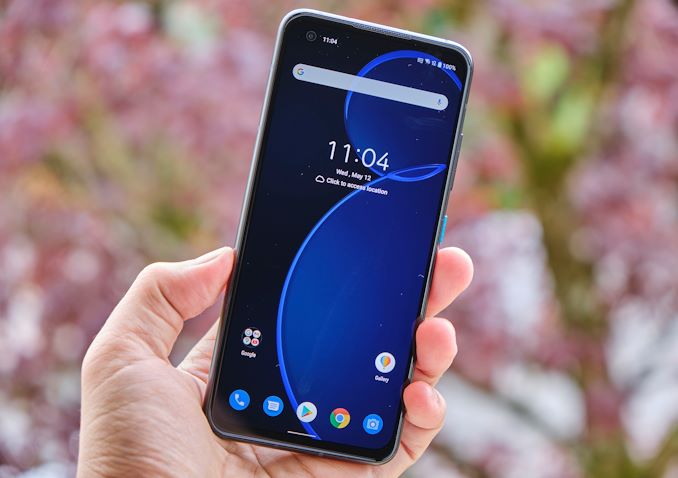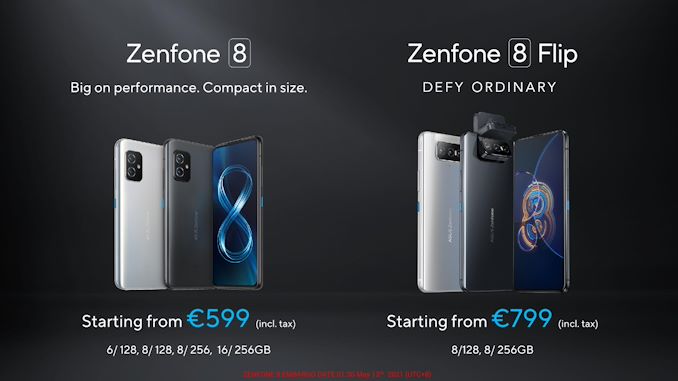The ASUS Zenfone 8 Hands-On Review: A New Compact Direction
by Andrei Frumusanu on May 12, 2021 1:30 PM EST- Posted in
- Smartphones
- Asus
- Mobile
- Zenfone 8
Conclusion & First Impressions
Today’s launch of the Zenfone 8 series is an interesting attempt by ASUS to position themselves in a gap in the market. The focus is clearly on the new Zenfone 8 which introduces as new smaller form-factor, and in many ways, it’s a unique device in the market because of that.
ASUS’s efforts in creating a smaller flagship phone work out well in terms of the actual form-factor and ergonomics of the Zenfone 8. The phone it actually reminded me the most of is the Pixel 5, both petite devices of similar dimensions, with the Zenfone 8 of course being built of more premium materials and having higher grade hardware components.
The display at 5.9” lands at a sweet-spot in terms of density for the 2400 x 1080 resolution. While we didn’t cover the matter in a dedicated section, I was actually impressed by the quality of the image calibration of the phone, allowing for near perfectly balanced white colour temperature in the settings, something many vendors struggle with. The 120Hz refresh rate of the panel is also great for general responsiveness of the device – however it comes at a cost of battery life.
While the phone has a 4000mAh battery, generally you can only expect good results in the 60Hz mode as like with many other devices this year, the Zenfone 8 features odd power consumption regressions. The 60Hz mode in turn comes at a cost of a regression of user experience that isn’t nearly as fluid as the 120Hz mode.
Performance of the phone is adequate, however aspects such as the sustained GPU and gaming performance of the phone, while adequate, isn’t the best due to the heavier throttling of such a smaller device.
Finally, there’s the cameras, and much like on the Zenfone 7 last year, it can be a deal-breaker for potential buyers. The camera hardware as well as the image processing just aren’t up to par with the competition. While the cameras are functional, they are well behind any competitor solution.
As we always say, there’s no bad product, just bad prices. In that regard, ASUS prices the Zenfone 8 at a very competitive 599€ starting price, which is far below the positioning of similarly specced competitors. The thing is though, is that while ASUS positions itself as a cheaper alternative, it also comes with quite a lot of drawbacks and compromises. Amongst the “small-phone” crowd, there’s really only the Xperia 5 III which isn’t available yet and comes at an eye-water 922€, or simply the Galaxy S21 which can be had today at 680€ - more expensive than the Zenfone 8, but also a vastly better device.
The Zenfone 8 Flip is quoted to start at 799€. Due to the meagre improvements of the Snapdragon 888 this year I would rather just advise to consider the Zenfone 7 at only 432€ right now if you’re after the flip-camera design, given that all other features and specifications between these two phones are the same.
Finally, there’s the continued issue of availability and limited releases depending on country and markets. I had asked ASUS about their recent track-record of having extremely slow roll-outs, with users sometimes waiting months to be able to purchase the phones in their specific region or country. Similarly, the Zenfone 8 series don’t have any concrete sell date or more specific pricing beyond the European start prices showcased in the above slide. ASUS had replied that they’re aiming to do better this year, but again shying away from disclosing any more concrete per-country availability information.
In that context, given the lack of availability dates as well as obvious better value competitor devices, it’s hard to recommend the new Zenfone 8 series phones – the company still has a lot of work ahead of it if it wants to be a contender in the mobile market.












66 Comments
View All Comments
Linustechtips12#6900xt - Thursday, May 13, 2021 - link
I do get it inefficient and I don't use it other than with dex but it something that's nice I was at a colts game and there was a wireless charging pad available for everyone and it happened to be i was without a charger and at about 20%, its just a convenience like a micro-sd or a headphone jack.nico_mach - Wednesday, May 19, 2021 - link
I think the drawbacks are overstated. I used wireless charging nightly on my s8 and the battery is still fine all these years later. The software, otoh...ads295 - Thursday, May 13, 2021 - link
I'm really liking this thing by the looks of it. IP rating + headphone jack + compact size + 4000mAh battery is a winning combination. Hope they work on the camera though, I'm sure the mediocrity lies in the software rather than the hardware.skydiverian - Thursday, May 13, 2021 - link
Can't stand notches or holepunch displays (i.e. I only want displays that are symmetrical on 2 axes - my Pixel 3a tbh still annoys me with rounded corners. Talking of the 3a, it's as big as I want to go. Guess I'll be holding onto it for the next 10 years at this rate. Otherwise this could be a contender for a replacement but I just can't stand that holepunch.Spunjji - Thursday, May 13, 2021 - link
I hated them at first, but got used to a notch after 2.5 years of owning a phone with one. Now have one with a punch-hole, I'd say it's neither an improvement nor a step back. I'd still prefer a top and bottom bezel and better front-facing speakers, but it's not the end of the world. Might be worth contemplating when it becomes time for a replacement.inperfectdarkness - Sunday, May 16, 2021 - link
This is why I love the Xperia XZ2 Compact. Bezels. The 18x9 form factor just looks better and feels better.c933103 - Thursday, May 13, 2021 - link
No. A 68-69mm wide phone is not compact. I have tried Xperia X Performance and Galaxy S10e. They don't fit in single hand. Now Zenfone 8 and Xperia 5 series are all trying to pretend they are compact but they aren't. The only option remaining is to spend 700USD to import an Aquos R2 Compact with Snapdragon 845 from Japan, or buy the Xperia XZ1 Compact with Snapdragon 835, for someone in Android ecosystem.ads295 - Thursday, May 13, 2021 - link
Both those devices aren't even in sniffing distance of 3000mAh battery capacity. Good luck with your battery life. At least the Sony uses 720p resolution which should help battery life, but the Aquos should be really mediocre with that high end chipset, high res display and relatively tiny battery size @2500mAh. I agree that phones could be still smaller but now we're talking about a fraction of an already small percentage of consumer base overall who want small phones.hemedans - Thursday, May 13, 2021 - link
xperia xz1 compact has best battery life than most flagship, better than many 4000 and 5000mah phones, usually i get 10+ hrs of on screen time. sd 835 was efficient and 720p help a lot.inperfectdarkness - Sunday, May 16, 2021 - link
2700mAh for xz1 compact. 2870mAh for xz2 compact.